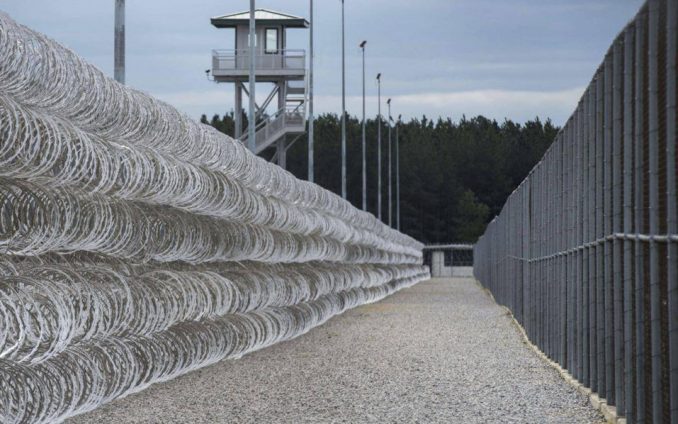Race, class and mass incarceration
SAN DIEGO
 San Diego — Author Curtis Howard, an activist in All of Us or None who is a formerly incarcerated person, brought to public attention the case of the Boundary Park Four and More.
San Diego — Author Curtis Howard, an activist in All of Us or None who is a formerly incarcerated person, brought to public attention the case of the Boundary Park Four and More.
Federal authorities announced indictments on May 25 against 23 men of color in San Diego. Among the defendants, four names stood out to local residents: Julius Davis, James Staton, Anthony Rhodes and Henry Hendrix. These four often frequent the local Dennis Allen Park, known colloquially as Boundary Park.
These men have an average age of 57 years. The minor drug sales and possession that make up the infractions they have been accused of are insignificant compared to the 20 years in prison they could be facing. As Howard originally articulated in his public correspondence, these indictments reflect the conservative response to progressive anti-prison legislation.
These indictments also unearth the limits of contemporary prison reforms, in that they fail to alter the material conditions the formerly incarcerated must live under.
With nearly 130,000 people in prison and another over 80,000 in jails, California, if measured as an independent country, has an inmate population that ranks in the top 10 in the world and rivals those in Mexico, Ukraine and South Africa.
In recent years, progressives in California mobilized support for and passed Proposition 47 (2014) and Proposition 57 (2016). Both referendums allowed for the reclassification of adult and juvenile sentences. At least 13,000 inmates have been released from California state prisons, and another 25,000 could be paroled.
Yet, formerly incarcerated people like the Boundary Park Four and More have come home to deindustrialized cities that are unprepared, and often unwilling, to meet the needs of aging formerly incarcerated people of color. They are too old for many of the reentry programs and too young for social assistance. Drug sales have become the ultimate act of survival for many by supporting their recreational habits.
Restructured economy endangered youth of color
The fight against mass incarceration is a racial struggle and a class struggle. Recently, Larry Holmes, First Secretary of Workers World Party, has urged reanalysis of class struggle and the position of groups generally disregarded by the mainstream labor movement, such as African-American youth. Now in their 50s and 60s, the Boundary Park Four and More sit on the cusp of Baby Boomers and Generation X (known as the hip hop generation by African-American scholars.) From the 1970s through the 1980s, it was their generation that first experienced the dramatic effects of restructuring of the American economy from the mid-20th-century Keynesian policy to neoliberalism. This included eliminating industrial jobs that had been unionized.
As radical professor Ruth Wilson Gilmore has shown in her works such as “Golden Gulag: Prisons, Surplus, Crisis, and Opposition in Globalizing California” (2007), Black and Brown youth were most impacted by this restructuring, and prisons became warehouses for surplus Black and Brown labor.
Some have focused their criticism on the profits gained from the exploitation of prison labor in state-run and for-profit prisons. Yet the case of the Boundary Park Four and More displays how prison labor is merely a bonus. Remembering the centrality of youth to radical movements of the 1950s, 1960s and 1970s, we can see how the mass incarceration of three generations of Black youth has held back mass mobilization.
Now, federal and state forces seem intent on completely throwing away the first generation impacted by deindustrialization.
Members of the Boundary Park Four and More are among the formerly incarcerated who have been sent home from prison with no concern for their employment, housing, food or health care. Still, California State Democratic Party officials have been rewarded with electoral victories for their support of the grassroots propositions.
On the other side, conservatives such as State Assemblyman Travis Allen and gubernatorial candidate John Cox have blamed these ballot measures that released prisoners for increasing crime in California and have promised to reverse propositions 47 and 57. They do this despite reports by the Public Policy Institute of California and others proving the contrary.
In 2000, Californians passed Proposition 36 to send people arrested for drug offenses for treatment instead of to prison. Yet, citing his own conviction in 2006, Curtis Howard has noted that state and federal agencies have evaded this reform by charging users as if they were dealers. As they did with Howard in 2006, police agencies entice users into participating in minor sales as middlemen between a dealer and a customer and then charge them as if they were large distributors.
For Howard, the sheer absurdity in charging the Boundary Park Four and More as dealers lies in the fact that none of these men have any recognizable assets: they own no cars or homes and don’t even have bank accounts. They likely have less than $100 disposable income, suggests Howard.
If the Boundary Park Four and More have any chance at freedom, they need the support of the community. As members of Workers World Party-San Diego, the Committee Against Police Brutality and the Black August Planning Committee organize this August, they will remind people that all prisoners are political prisoners. For this reason, these organizations have called for a protest in solidarity with the Boundary Park Four and More at the federal courthouse in downtown San Diego on Aug. 10.

